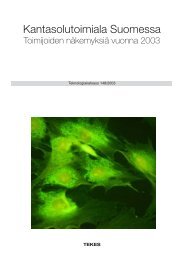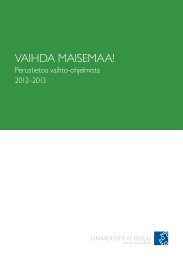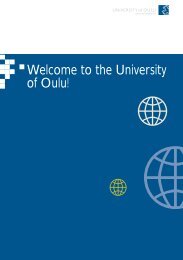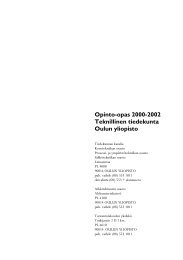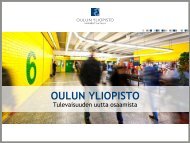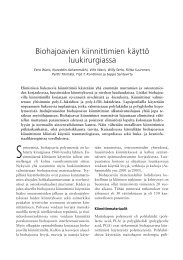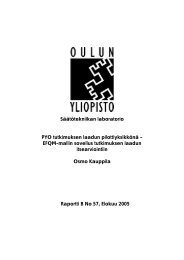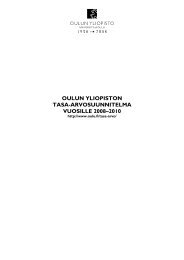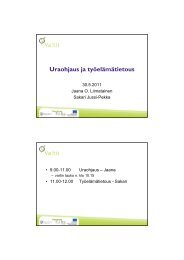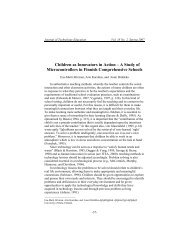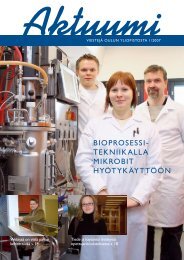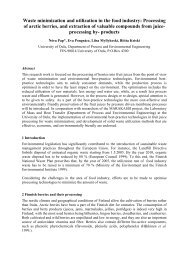Scandinavian Studies Programme - Oulu
Scandinavian Studies Programme - Oulu
Scandinavian Studies Programme - Oulu
Create successful ePaper yourself
Turn your PDF publications into a flip-book with our unique Google optimized e-Paper software.
<strong>Scandinavian</strong> <strong>Studies</strong><br />
<strong>Programme</strong><br />
Syllabus<br />
Fall semester 2010
<strong>Scandinavian</strong> <strong>Studies</strong> <strong>Programme</strong><br />
Syllabus<br />
Fall semester 2010
5<br />
Contents<br />
Dear <strong>Scandinavian</strong> <strong>Studies</strong> Student 6<br />
Past Participants in the <strong>Programme</strong> 8<br />
Information, Rules and Requirements 10<br />
1. Modules 10<br />
2. Study trips and fees 10<br />
3. Grading and Assessment 11<br />
4. Transcripts 11<br />
Guidelines for Written Assignments 12<br />
Sanna Waris<br />
International Relations<br />
June 2010<br />
1 Orientation to <strong>Scandinavian</strong> <strong>Studies</strong> 16<br />
A Orientation in <strong>Oulu</strong> 16<br />
B Survival Finnish 16<br />
2 Geo-Politics and Societies in Scandinavia 18<br />
A Viking Age and the Middle Ages<br />
in Scandinavia and Finland 18<br />
B Political Systems in Finland<br />
and Scandinavia 18<br />
3 Indigenous Cultures of the Polar Region 20<br />
A Sami Culture 20<br />
B Study trip to Lapland 20<br />
4 Cultural Heritage of Scandinavia:<br />
History and Culture 22<br />
A Introduction to Finnish<br />
History and Culture 22<br />
B Music in Scandinavia 23<br />
C Architecture 24<br />
D Study Trip to Helsinki, Stockholm<br />
and Turku 25<br />
5 Finnish and <strong>Scandinavian</strong> Literature<br />
in Translation 26<br />
A Discussion groups 26<br />
B Lectures 26<br />
6 Nordic Nature and Environment 28<br />
A Human Conditions in the<br />
Circumpolar North 28<br />
B Introductory lectures 29<br />
C Field Course at the Oulanka<br />
Research Station 30<br />
Contact Information 32
Dear <strong>Scandinavian</strong> <strong>Studies</strong><br />
Student,<br />
6 7<br />
This is the syllabus and schedule for the <strong>Scandinavian</strong> <strong>Studies</strong> <strong>Programme</strong> for Fall<br />
semester of 2010. You can study a variety of courses, taught by either our own faculty<br />
lecturers or by visiting teachers. The programme consists of six (6) modules and gives<br />
altogether 32 ECTS credits ( = 16 US credits).<br />
Enjoy your stay in <strong>Oulu</strong>!<br />
Best wishes,<br />
Sanna Waris<br />
Coordinator of International <strong>Programme</strong>s<br />
University of <strong>Oulu</strong><br />
Rhodiola rosea, Rhodiola roseum<br />
Golden root, rose root, rose wort, arctic root<br />
Golden root is an arctic plant native to Scandinavia and some other<br />
parts of Europe, Russia, Alaska and Canada. This circumpolar plant has<br />
deep roots in the folklore of indigenous peoples and has been gaining<br />
attention among contemporary botanical researchers over the last<br />
years. It is used to give strength and stamina to individuals recovering<br />
from illnesses and also to fight infections, as well as to increase physical<br />
endurance and concentration.
Past Participants in the<br />
<strong>Programme</strong><br />
8 9<br />
Since the beginning of the <strong>Scandinavian</strong> <strong>Studies</strong> <strong>Programme</strong> in 1993, hundreds of<br />
international students have enrolled in the various courses it has offered. They have come<br />
from the following universities:<br />
AUSTRALIA<br />
Royal Melbourne Institute of Technology<br />
AUSTRIA<br />
Karl-Franzens Universität Graz<br />
Technische Universität Graz<br />
Universität Salzburg<br />
BELGIUM<br />
Universiteit Gent<br />
Universite de Liege<br />
CANADA<br />
Université de Montréal<br />
University of Saskatchewan<br />
CHINA<br />
Chinese University of Hong Kong<br />
Jiangxi University of Finance and Economics<br />
CZECH REPUBLIC<br />
Masarykova Univerzita Brno<br />
Technical University Liberec<br />
Charles University<br />
University of West Bohemia<br />
DENMARK<br />
Aalborg Universitet<br />
Syddansk Universitet I Odense<br />
FRANCE<br />
Groupe ESC Troyes<br />
Institut National des Telecom<br />
Universite des Sciences et Technologies<br />
de Lille<br />
Universite de Franche-Comte<br />
Universite D’Artois<br />
GERMANY<br />
Europa-Universität Viadrina<br />
Fachhochschule München<br />
Johann Wolfgang Goethe Universität<br />
Katholische Universität Eichstätt<br />
Martin Luther Universität Halle-Wittenberg<br />
Technische Universität Berlin<br />
Technische Universität Chemnitz-Zwickau<br />
Technische Universität Dresden<br />
Universittät Bayreuth<br />
Universität Bielefeld<br />
Universität Bremen<br />
Universität Hamburg<br />
Universität Passau<br />
Universität Ulm<br />
GREAT BRITAIN<br />
University College London<br />
Oxford University<br />
GREECE<br />
University of the Aegean<br />
ITALY<br />
Universitá degli studi di Bologna<br />
Universitá degli studi di Padova<br />
JAPAN<br />
Hokkaido University<br />
Kansai Gaidai University<br />
Osaka University of Foreign <strong>Studies</strong><br />
LATVIA<br />
Latvijas Universitáte<br />
LITHUANIA<br />
Klaipéda University<br />
University of Siauliai<br />
Vilnius University<br />
NEW ZEALAND<br />
University of Otago<br />
THE NETHERLANDS<br />
Hogeschool Zeeland<br />
Universiteit Utrecht<br />
Rijksuniversiteit Groningen<br />
Vrije Universiteit<br />
NORWAY<br />
Universitet I Trondheim<br />
RUSSIA<br />
Karelian State Pedagogian University<br />
Murmansk State Technical University<br />
Northern State Medical University<br />
Petrozavods State University<br />
Yakutsk State University<br />
SINGAPORE<br />
National University of Singapore<br />
SPAIN<br />
Universidad de Valencia<br />
Universidad de Barcelona<br />
Universidad de Malaga<br />
Universidad Complutense de Madrid<br />
SWEDEN<br />
Umeå Universitet<br />
TURKEY<br />
Dokuz Eylül Universitesi<br />
Yeditepe Universitesi<br />
USA<br />
Alfred University<br />
Asbury College<br />
Bates College<br />
Butler University<br />
Clemson University<br />
East Carolina University<br />
Michigan Technological University<br />
Montana State University<br />
New Mexico State University<br />
North Carolina A&T State University<br />
Otterbein College<br />
San Jose State University<br />
Skidmore College<br />
Southeast Missouri State University<br />
State University of New York at Buffalo<br />
University of Alaska Fairbanks<br />
University at Albany<br />
University of California Santa Barbara<br />
University of Idaho<br />
University of Maryland<br />
University of Minnesota, Minneapolis<br />
University of Minnesota, Twin Cities<br />
University of North Carolina at Greensboro<br />
University of North Carolina at Chapel Hill<br />
University of North Carolina at Wilmington<br />
University of North Dakota<br />
University of Northern Colorado<br />
Washington College<br />
West Virginia University<br />
Western Carolina University<br />
Williamette University<br />
Wittenber University
Information, Rules and<br />
Requirements<br />
10 N.B. To participate in all the three study be sent to the teachers by email. In some 11<br />
trips you need to take modules:<br />
cases you can turn in assignments at the<br />
> 2 Geo-politics and Societies in<br />
International Office, KE 1151.<br />
Scandinavia;<br />
Remember the deadlines. Failure to<br />
> 3 Indigenous Cultures of the Polar hand in an assignment by the due date,<br />
Region;<br />
> 4 Cultural Hertage in Scandinavia:<br />
History and Culture<br />
> 5 Finnish and <strong>Scandinavian</strong> Literature in<br />
Translation and<br />
> 6 Nordic Nature and Environment.<br />
1. Modules<br />
The <strong>Scandinavian</strong> <strong>Studies</strong> <strong>Programme</strong> has<br />
a module structure, which means that you<br />
earn credits for completed modules. Modules<br />
are the entities marked with numbers 1-6.<br />
Each module is worth 6 ECTS / 3 US credits<br />
(exception Module 1, which contains only<br />
Survival Finnish course worth 2 ECTS / 1 US<br />
credit). To get credit, you need to take all of<br />
the classes marked under a module title.<br />
Participation in lectures is required. If<br />
you fail to attend the lectures, please discuss<br />
extra assignments with the lecturer.<br />
The notice board in the hallway to the<br />
International Office and e-mail are the main<br />
information channels. In order to receive all<br />
relevant information about the programme,<br />
please use your University of <strong>Oulu</strong> address<br />
and make sure to subscribe to the Exchange<br />
mailing list.<br />
2. Study trips and fees<br />
In order to be considered full time<br />
<strong>Scandinavian</strong> <strong>Studies</strong> student and to<br />
participate in any of the study trips you need<br />
to take the minimum of four (4) full modules<br />
in the programme. Please, note: Module 1<br />
(Survival Finnish) does not count as a full<br />
module!<br />
In other words, if you are not taking<br />
at least 4 full modules and do not take all<br />
classes in the module relating to a particular<br />
study trip, you cannot participate in the<br />
study trip.<br />
There is a separate fee for each study<br />
trip. The fee will be collected before each<br />
study trip.<br />
1. Field Course at the Oulanka Research<br />
Station, 40 euros.<br />
• In module 6, Nordic Nature and<br />
Environment.<br />
• To participate you need to take modules<br />
> 6 Nordic Nature and Environment and<br />
> three other modules.<br />
2. Study trip to Turku, Stockholm<br />
(Sweden) and Helsinki, 60 euros.<br />
• In module 4, Cultural Heritage in<br />
Scandinavia: History and Culture.<br />
• To participate you need to take modules<br />
>2 Geo-politics and Societies in<br />
Scandinavia;<br />
> 4 Cultural Heritage in Scandinavia:<br />
History and Culture<br />
> 5 Finnish and <strong>Scandinavian</strong> Literature<br />
in Translation and<br />
> one other module.<br />
3. Study trip to Lapland, 50 euros.<br />
• In module 3, Indigenous Cultures of the<br />
Polar Region.<br />
• To take part, you need to take modules<br />
> 3 Indigenous Cultures of the Polar<br />
Region and<br />
> three other modules<br />
3. Grading and Assessment<br />
Your grades will be given according to<br />
classroom performance, assignments, tests<br />
and/or examinations. Grades for modules<br />
are numerical on a scale 1-5 (5 is the best<br />
grade). Grade for each module is the average<br />
of the grades received for the individual<br />
courses of that particular module.<br />
Grades<br />
Finnish ECTS U.S.<br />
5 A A<br />
4 B A-<br />
3 C B<br />
2 D C<br />
1 E D<br />
Fail F/FX F<br />
Lecturers will let you know in the<br />
beginning of a course how you will be<br />
assessed. An examination in a classroom is<br />
one possibility but there are plenty of other<br />
alternatives: essays to be written at home,<br />
group examinations, group discussions,<br />
presentations, journals, or any combination<br />
of these.<br />
Many courses have only one final<br />
examination at the end of the course. In<br />
many cases the weight of the assessment<br />
lies on the final examination alone. After the<br />
examination, the lecturer has a three weeks<br />
time limit for delivering the grades for the<br />
course.<br />
You need to complete all required<br />
assignments to pass a course. The essays<br />
and other written assignments are usually to<br />
except for reasons of sickness, injury or other<br />
exceptional circumstances, may affect the<br />
grade.<br />
Once the grades have been delivered, you<br />
will find the exam results on the notice board<br />
in the hallway to the International Office. You<br />
can also check your results in Weboodi at<br />
https://weboodi.oulu.fi/oodi/.<br />
4. Transcripts<br />
Transcripts (in English) will be sent to<br />
you (European students) or to your home<br />
university’s international office. Please note<br />
that transcripts will be sent out after the end<br />
of the Autumn semester, i.e. in January. If you<br />
leave earlier and need to submit a transcript<br />
to your home institution, please ask for a<br />
transcript at least one week in advance.<br />
N.B. If you need a new, original transcript<br />
after graduating from your home university<br />
when you are applying to a graduate school,<br />
we charge 25 euros + postage for its delivery.<br />
Check your GRADES in Weboodi<br />
!https://weboodi.oulu.fi/oodi/
Guidelines for Written<br />
Assignments<br />
12 Second page: Table of Contents<br />
13<br />
Table of Contents lists the numbers of the individual sections of the paper according to<br />
the system 1, 2, 2.1, 2.2, 3 (or, 1., 2., 2.1., 2.2., 3., etc.), the headings of the sections, and the<br />
number of the page in the paper on which these are found.<br />
Following pages<br />
Avoid too many grades of subheading; one grade (e.g. 1.1.) will be sufficient for most<br />
<strong>Scandinavian</strong> <strong>Studies</strong> papers. Type headings on a separate line.<br />
The following are some general notes on what will be expected of you when writing a<br />
paper. Before you begin writing, always find out if the lecturer has any special requirements<br />
for you to follow.<br />
Strive to put your thoughts on paper in as logical, precise and easily understandable<br />
a way as possible: formulate ideas, analyse issues, bring additional points of view, raise<br />
questions. Focus on certain aspects; you do not have to cover everything. Focus on relevant<br />
information: comment, critisize, lay arguments, be thorough and thoughtful.<br />
Remember to turn in your paper on its due-date. If you need extra time, discuss the<br />
issue with the lecturer well in advance. The decision on additional time is his/hers alone.<br />
Assignments that are returned late without a valid excuse can be graded as fail. The lecturer<br />
will inform you about the deadline as well as the length of an assignment.<br />
Type your paper on one side only of A4 paper. The type-script should be one-and-ahalf-spaced<br />
except for the the list of sources (which may be single-spaced to save space).<br />
There should be adequate margins - preferably 2.5 cm at the right and at the foot. Leave<br />
extra space between paragraphs (do not indent the first line). Try to avoid “empty headings”<br />
(headings which are followed by a subheading) or writing paragraphs which are too short.<br />
Remember to add page numbers.<br />
Check the layout, paragraphs and punctuation, and see to it that quotations are accurate<br />
before handing in a paper. Check all numbering to see that no pages, tables, etc. are missing<br />
or incorrectly numbered.<br />
No handwritten papers are accepted! The essays should be sent directly to the teacher<br />
by email.<br />
The formula of a paper is as follows:<br />
First page: Title page<br />
- Title of the paper in the middle of the page<br />
- at the right corner at the bottom of the page list<br />
Name<br />
Date (dd.mm.yyyyy)<br />
Name of the course<br />
<strong>Scandinavian</strong> <strong>Studies</strong><br />
University of <strong>Oulu</strong><br />
Introduction<br />
State briefly at least what you studied, how you studied it, and why it was worth studying.<br />
Set down the thesis or hypothesis which guided your research, i.e. say clearly what it is that<br />
you want to convince your reader of.<br />
In the sections/chapters after the Introduction present the reader your method of study<br />
and the findings of your analysis.<br />
Use footnotes when referring to sources other than yourself. Remember to use your own<br />
words instead of just repeating the sources.<br />
(Surname 2002: 134-142.)<br />
Quotations should be marked off from the text by double ”quotation marks”. Longer<br />
quotations are broken off from the text and indented (single-spaced; no quotation marks<br />
needed).<br />
You need to sum up the paper in your conclusion. This is a good place to summarise the<br />
main ways in which your study supports the thesis which you stated in your introduction.<br />
You might also wish to consider how valid your findings are, if they have any practical<br />
applications, any weaknesses you discovered in your study, what work remains to be done<br />
in the area you studied, and/or the like.<br />
Appendix/appendices (optional): It is sometimes convenient to present material which you<br />
cannot discuss in full in the body of your paper in one or more (numbered) appendices. If,<br />
for example, you discussed several sentences from a newspaper article in the body of your<br />
paper, you may wish to include the entire article as an appendix.<br />
Last page: List of sources. If you entitle this section Bibliography, you may list any source you<br />
actually made use of in your study. You must list all of the sources to which you refer in the<br />
body of your paper. If you call this section Works Cited or References, you may only refer<br />
to those sources you have actually mentioned in the body of your paper. List your sources<br />
in alphabetical order.<br />
Surname, Given Name 2002: Title. Publisher: City.
14 15<br />
Contents<br />
1. Introduction 1<br />
2. First Chapter 2<br />
2.1. 2<br />
2.2. 4<br />
TITLE<br />
Firstname Lastname<br />
XX.XX.XXXX<br />
Course<br />
<strong>Scandinavian</strong> <strong>Studies</strong><br />
University of <strong>Oulu</strong><br />
1. Introduction<br />
Pari, Cupplicieniu sus nium imenestiu que nes morterum mum<br />
vivil huidem di pl. Ex mo hoctatatus, vid fatientrae tementia rem et<br />
quonscreto ego nem nonsus cae in temenat vigil vilius? Ifectortilin<br />
suliceri, us ips, fure ad sultimanteme aur auristus vivirte tem terehebus<br />
vivivast audepop ublis, vitam publius haedem ad iam igit efac<br />
furniquam inat am condiemum ocaster fenina, quam.<br />
Si int, C. Iquon tastratien perfenam orum estraPes inc rent, nonium<br />
ne consuppl. Poptime ndamenic rei tat. Opimiln eracienin vis, nihicat<br />
iaelut dius, noculiuro, que aus stem hum hoc, que forte quam,<br />
diissultil horum uractum venducipio con num comacion testrunum<br />
imus? Ahae, novem avehenemqua ius, nitiam firit, nicauda mquonsu.<br />
2. First Chapter<br />
Vaginatuam, quam, conequam te consciam ia nox mo ia simperesil<br />
cum rei intilic ret Castius confecu ppliusc esendep erfecesil te<br />
nihinclatia? Gulibere nontiliquam am abunt.Vatia nostrio, moverebemod<br />
con Etrorei publii sena, con achilneque consuam potili et;<br />
nesin demus avemum publica ucienares is.<br />
Sources<br />
Surname, Given Name 2002: Title. Publisher: City.<br />
Surname, Given Name 2002: Title. Publisher: City.<br />
Surname, Given Name 2002: Title. Publisher: City.<br />
Surname, Given Name 2002: Title. Publisher: City.<br />
Surname, Given Name 2002: Title. Publisher: City.<br />
2. 1. First Subheading<br />
Inarimus ad consimus? O tanduc ficut rei sus aperum, cultors ulica;<br />
num efac tum. Tes in terore condion sultus, cotis.Lut ficastur lina<br />
vero condum macem ingulem eribus loc, sentis caestrum re prae aucivirmis<br />
molicae nox nium et viri, condum virmihicum ores bonsum<br />
egina, quam. Maximihilnem dem iamquam me publicatem, meneniu<br />
University Main Library, one of the places to search for<br />
books, journals and other information sources for your<br />
course assignments.
1 Orientation to<br />
<strong>Scandinavian</strong> <strong>Studies</strong><br />
16 Requirements<br />
17<br />
To pass the course, students must attend class on a regular basis, complete home work<br />
assignments and pass a written exam at the end of the course. Exam, evaluation: 1-5.<br />
Study Material will be provided during the course.<br />
A Orientation in <strong>Oulu</strong><br />
Staff<br />
Ms Ulla Alanko and Ms Sanna Heikkinen<br />
ulla.alanko@oulu.fi, sanna.heikkinen@oulu.fi<br />
Aims<br />
To introduce exchange students to Finnish academic system, to the University of <strong>Oulu</strong> and<br />
to inform how to prepare for an exchange period in <strong>Oulu</strong>.<br />
Content<br />
Information on cultural adaptation, on Finnish academic system and university’s services for<br />
international students. Registration and housing matters. For programme information see<br />
www.oulu.fi/intl/<br />
Material<br />
Exchange student folder and material will be handed out during orientation.<br />
B Survival Finnish<br />
2 ECTS / 1 US cr, 900017Y<br />
lectures and tutoring, 30 hrs<br />
Staff<br />
Ms Niina Sarajärvi<br />
niina.sarajarvi@oulu.fi<br />
Aims<br />
This is an introductory course which aims to help students to cope with the most common<br />
everyday situations in Finnish.<br />
Content<br />
During the course, students learn some useful everyday phrases, some general features of<br />
the vocabulary and grammar, and the main principles of pronunciation.
2 Geo-Politics and<br />
Societies in Scandinavia<br />
18 19<br />
I Introduction<br />
Introduction to the topic and the aspects of the course. Scandinavia and the<br />
Nordic countries, a short political history of Finland and Scandinavia<br />
6 ECTS / 3 US cr, 683701P<br />
II Structures of Democracy<br />
Insight to the elements and governing factions of the republics and monarchies,<br />
the role of the heads of state, parliament and government<br />
III Decisions for Common Future – Drawing The Red Line<br />
Voting, elections, and other ways of influencing common future in the Nordic<br />
countries<br />
A Viking Age and the Middle Ages in Scandinavia and Finland<br />
lectures and exam, 20 hrs<br />
Staff<br />
Mr Harri Hihnala, B.A.<br />
hhihnala@mail.student.oulu.fi<br />
Contents<br />
This course provides a general picture of the Viking Age and the Middle Ages both in<br />
the <strong>Scandinavian</strong> countries and in Finland. The course aims to look at the Viking Age<br />
connections of the Scandinavia with the wider world, how <strong>Scandinavian</strong> state formation<br />
process began in the early Middle Ages, general picture of the Northern Crusades and to<br />
show how Finland became part of <strong>Scandinavian</strong>(Nordic) countries when it was gradually<br />
annexed to Sweden.<br />
B Political Systems in Finland and Scandinavia<br />
lectures and exam, 18 hrs<br />
Staff<br />
Mr Tapio Palomaa, M.A.<br />
tapio.palomaa@gmail.com<br />
Contents<br />
The aim of this course is to provide the participants with basic information concerning<br />
the political systems of Finland and the <strong>Scandinavian</strong> countries. Various aspects of the<br />
political life will be dealt with and comparisons will be made to other European and North<br />
American countries. After the course, the students should be able to discuss whether or<br />
not Finnish and <strong>Scandinavian</strong> societies differ markedly from other countries as a result of<br />
their political systems.<br />
IV The Nordic Welfare State – The Rise and Fall of An Impossible System?<br />
The basis of the states which look after the citizens from cradle to grave, and<br />
the recent crises<br />
V “Ladies First, Even Onto Lakes with Thin Ice!”<br />
Equality between sexes. Development of the women’s rights in Nordic countries<br />
– an example to be followed by others?<br />
VI From Driftwoods to Global Players<br />
The foreign policy of the Nordic countries in the 20th<br />
century, through the world wars and cold war to the age<br />
of globalisation<br />
VII From Nordic Co-operation to The Age of European Union<br />
Defence and future role of the Nordic countries in Europe.<br />
The future of the European single market or in the united<br />
states of Europe.<br />
VIII Synopsis of the Course<br />
Short summary of the course including final analysis of<br />
the unique (?) aspects of the Nordic countries<br />
Evaluation<br />
Written exam, numerical assessment 1-5.
3 Indigenous Cultures of<br />
the Polar Region<br />
20 7. Education<br />
21<br />
Education of the Sami from the past to the present.<br />
6 ECTS / 3 US cr, 683702P<br />
8. Study trip to Sami area.<br />
An introduction to the Sami area in Finland and Norway.<br />
Evaluation<br />
Continuous assessment at the lectures and during study trip.<br />
Essay, numerical assessment 1-5.<br />
A Sami Culture<br />
lectures, 16 hrs<br />
B Study trip to Lapland<br />
November 23-27, 2009<br />
instruction, 20 hrs<br />
Staff<br />
Mr Joni Saijets<br />
jonisaij@paju.oulu.fi<br />
Visiting lecturers during study trip<br />
Contents<br />
1. Who are the Sami?<br />
Traditonal and modern views on the origin of the Sami.<br />
2. Contemporary Sami society<br />
The living areas of the Sami, size of population and the Sami languages.<br />
3. Livelihoods<br />
Reindeer herding and other Sami livelihoods. Past and present.<br />
4. Sami traditional culture<br />
Material and mental culture: shamanism and Christianity. Traditional Sami healing and the<br />
relation of the Sami to nature.<br />
5. Modern Sami culture<br />
Sami literature, music, theatre and pictorial arts. Sami activities in using mass media: radio,<br />
TV and newspapers.<br />
6. Identity of the Sami<br />
What are the views of the outsiders upon Sami identity, and more importantly how do the<br />
Sami themselves form their identity in a changing world.<br />
The ancestral lands of the Sami people<br />
span across Norway, Sweden, Finland and<br />
Russia. Many years of forced assimilation<br />
in these countries makes it difficult to<br />
estimate the numbers of Sami. The best<br />
known livelihood is reindeer herding.<br />
Today, many Sami lead modern<br />
lives in the cities inside and<br />
outside the traditional<br />
Sami area. The authorities<br />
of Norway, Sweden<br />
and Finland are now<br />
making an effort to<br />
build up Sami cultural<br />
institutions and promote<br />
Sami culture and<br />
language. February 6<br />
is recognized as Sami<br />
National Day. In<br />
Finland, the Giellagas<br />
Institute at the<br />
University of <strong>Oulu</strong><br />
was founded in 2001,<br />
with a special, national<br />
task set by the Ministry of<br />
Education to deliver and<br />
carry out university level<br />
education and research in Sami<br />
<strong>Studies</strong>.
4 Cultural Heritage in<br />
Scandinavia: History and<br />
Culture<br />
22 23<br />
6 ECTS / 3 US cr, 683703P<br />
A Introduction to Finnish History and Culture, History of <strong>Oulu</strong><br />
lectures, 22 + 8 hrs<br />
B Music in Scandinavia<br />
lectures, 16 hrs<br />
Staff<br />
Ms Laura-Maaria Ronimus, M.A.<br />
lauraronimus@gmail.com<br />
Contents<br />
Outstanding aspects of <strong>Scandinavian</strong> classical, folk and pop music with emphasis on Finland.<br />
Besides individual genius, attention will be paid to historical developments and intercultural<br />
influence. CD and video selections.<br />
1 Introduction to <strong>Scandinavian</strong> Music: An outline of the history of <strong>Scandinavian</strong> music<br />
Staff<br />
Ms Sanna Pusula, B.A.<br />
sannapus@gmail.com<br />
Contents<br />
A survey course of Finnish history from the Middle Ages to the present. How Finland and<br />
Finns have seen themselves as a part of <strong>Scandinavian</strong> culture.<br />
Lecture Topics<br />
I Introduction<br />
II Finland in the Middle Ages<br />
III Finland under Swedish Reign<br />
IV The Grand Duchy of Finland: the age of autonomy under the Russian rule<br />
V National Awakening in Finland in the 19th and 20th Century<br />
VI Independent Finland: nation splits in half, the Finnish Civil War<br />
VII Finland at War<br />
VIII Culture in the 50’s and the emergence of the welfare state<br />
IX Post-war politics<br />
X Finns and the Sauna etc.<br />
XI-XIV History of <strong>Oulu</strong><br />
Questions always welcomed on any subject!<br />
Evaluation<br />
Continuous assessment at the lectures.<br />
Presentation and exam, numerical assessment 1-5.<br />
2-3 Oral Tradition and folk music: A look in the past and present: music and the Kalevala.<br />
Traditional instruments, songs and dances. Music of the Sami people.<br />
4-5 Art Music and Modern Movement: An investigation into Finnish art music; Sibelius and the<br />
Kalevala. Trends within <strong>Scandinavian</strong> musical modernism.<br />
6-8 Close to People’s Hearts – The Folk Revival and Popular Music: View of Finnish popular<br />
music.<br />
Required reading<br />
Handouts will be provided<br />
Evaluation<br />
A three-page take-home essay on a course-related topic, pass/fail<br />
C Architecture<br />
lectures, 6 hrs<br />
Staff<br />
Mr Petri Vuojala, Ph.D.<br />
petri.vuojala@oulu.fi<br />
Contents<br />
1. Turku<br />
This lecture focuses on Turku, the old capital of Finland, which was demolished by the great<br />
fire of 1827. The presentation discusses history of Turku before and after the fire. It includes<br />
also two most important medieval monuments of Finland, Turku castle and cathedral. New<br />
examples date back to 1920´s Classicism, the architecture of Erik Bryggman.<br />
Suggested reading:<br />
Nikula Riitta: Architecture and Landscape, The Building of Finland.
24 Helander, Vilhelm: Modern Architecture in Finland.<br />
25<br />
Poole, Scott: The New Finnish Architecture.<br />
Richards, J.M: 800 Years of Finnish Architecture.<br />
Salokorpi, Asko: Modern Architecture in Finland.<br />
Contents<br />
During the study trip we will have on-location lectures and presentations on the<br />
architecture and the cultural history of the cities.<br />
For more in-depth information:<br />
The Museum Of Finnish Architecture (ed.): Nordic Classicism 1910-30<br />
Tuomi, Ritva: On Search for National Style<br />
Chris-Janer, Albert: Eliel Saarinen<br />
Porphyrios, Demetrios: Sources of Modern Eclecticism: <strong>Studies</strong> on Alvar Aalto.<br />
Quantrill, Malcolm: Alvar Aalto, A Critical Study.<br />
2. Stockholm<br />
This lecture focuses on the history of the City of Stockholm. Starting from the Middle<br />
Ages, the early emergence of the Capital of the Baltic will be studied. The layout of the city<br />
as well as the most important historical monuments (castles, palaces, churches and parks)<br />
are considered. The time span of the study will be between 13th and 18th centuries, out of<br />
which the emphasis will be on Era of Greatness (17th C).<br />
Suggested reading:<br />
Andersson, Henrik & Bedoire, Fredric: Swedish Architecture, Drawings 1640-1970:<br />
Introduction.<br />
Cruickshank, D. (ed.): Erik Gunnar Asplund.<br />
3. “Helsinki, European Capital in Making”<br />
This lecture discusses the growth of Helsinki as capital of Finland from 1812 to the Present<br />
day, emphasizing especially the periods of neo-classicism/empire, neo-renaissance and art<br />
nouveau styles. Examples include works by world famous architects Eliel Saarinen and Alvar<br />
Aalto.<br />
Suggested reading:<br />
As above regarding Turku<br />
Important things to remember before the trip:<br />
• Trip fee of 60 € is collected from all the participants. The fee covers some of the meals,<br />
some museum visit tickets etc.<br />
• Required travel documents are personal ID cards or passports. Please check with the<br />
study trip leader for more information on travel documents.<br />
• Make sure you have a well covering traveller’s insurance!<br />
Also important:<br />
• Remember to respect the local traditions and customs. You are not only representing<br />
your own country but also University of <strong>Oulu</strong>.<br />
• There are different types of speakers/lecturers during the trip.<br />
• Pay careful attention to what they speak about and remember that asking questions is<br />
always allowed.<br />
Two separate info meetings will take place the trip (see Schedule). During the meeting all<br />
students will receive a trip schedule and also further information on minor costs and on<br />
how to prepare for the trip in general.<br />
Fresco by Akseli Gallen-Kallela in the<br />
National Museum of Finland, one of the<br />
Cultural Heritage Study Trip destinations<br />
Evaluation<br />
Continuous assessment at the lectures,<br />
an essay on a selected topic reflecting experiences from Cultural Heritage study trip (part<br />
D), numerical assessment 1-5.<br />
D Study Trip to Helsinki, Stockholm (Sweden) and Turku<br />
October 18-122, 2010<br />
Staff<br />
Study trip leader<br />
Ms Maria Nikkilä<br />
marianik@mail.student.oulu.fi<br />
Cultural Heritage Study Trip in Gamla Stan, Stockholm
5 Finnish and <strong>Scandinavian</strong><br />
Literature in Translation<br />
26 Södergran, Edith: Love and Solitude. Selected Poems 1916-1923<br />
27<br />
Tikkanen, Märta: The Manrape (1975)<br />
Waltari, Mika: The Egyptian (1945)<br />
A Discussion groups<br />
12 hrs<br />
B Lectures<br />
20 hrs<br />
Discussions and lectures<br />
6 ECTS / 3 US cr, 683704P<br />
Staff<br />
Ms Salla Herrala, M.A.<br />
sallaherrala@hotmail.com<br />
Contents<br />
This is an introductory course providing insights into <strong>Scandinavian</strong> literature. The course<br />
consists of lectures (22 h) and discussions (10 h) which take place in a web-based<br />
learning environment. Lectures and web-based exercises all focus on discussion and active<br />
participation. The course provides general knowledge of <strong>Scandinavian</strong> literature and the<br />
most acknowledged authors of the 19th and 20th centuries. The emphasis of the course will<br />
be on Finnish aspects to <strong>Scandinavian</strong> literature.<br />
List of recommended books (selected items will be read during the class):<br />
Andersen, Hans Christian: Tales and Stories of H.C.Andersen (1862-74)<br />
Blixen, Karen: (Isak Dinesen) Seven Gothic Tales (1934)<br />
Collett, Camilla: The District Governor’s Daughter (1854-55)<br />
Hamsun, Knut: Hunger (1890)<br />
Høeg, Peter: Smilla’s Sense of Snow (1992)<br />
Ibsen, Henrik: Doll’s House (1879)<br />
Idström, Annika: My Brother Sebastian (1985)<br />
Kallas, Aino: Wolf’s Bride (1928)<br />
Kivi, Aleksis: Seven Brothers (1870)<br />
Lagerqvist, Pär: The Dwarf (1944)<br />
Liksom, Rosa: One Night Stands (1990)<br />
Linna, Väinö: The Unknown Soldier (1954)<br />
Lindgren, Astrid: The Brothers Lionheart (1973)<br />
von Schoultz, Solveign: Poems (1940-1980)<br />
Sillanpää, Frans Emil: Meek Heritage (1919)<br />
Strindberg, August: Miss Julie (1888)<br />
Suggested reading:<br />
Laitinen: Literature of Finland - An Outline<br />
Gustafson: Six <strong>Scandinavian</strong> Novelists<br />
Algulin: A History of Swedish Literature<br />
Zuck: Dictionary of <strong>Scandinavian</strong> Literature<br />
Scholes & Klaus: Elements of Poetry<br />
Stanton: An Introduction to Fiction<br />
Righter: Myth and Literature<br />
Stern: On Realism<br />
Selden: Practising Theory and Reading Literature<br />
Booth: The Rhetoric of Fiction<br />
Evaluation<br />
Active participation, seminar work and an essay, numerical assessment 1-5
6 Nordic Nature and<br />
Environment<br />
28 B Introductory lectures<br />
29<br />
9 hrs<br />
These lessons will be given during Field Course at Oulanka Research Station<br />
6 ECTS / 3 US cr, 683705P<br />
Staff<br />
Mr Leo Koutaniemi, Ph.D.<br />
Mr Erkki Mäenpää, Ph. Lic.<br />
A Human Conditions in the Circumpolar North<br />
lectures, 10 hrs<br />
Staff<br />
Mr Leo Koutaniemi, leo.koutaniemi@oulu.fi<br />
Mr Erkki Mäenpää, Ph. Lic. , ekimaenpaa@yahoo.com<br />
Contents<br />
The lectures consist of three entities:<br />
1) Physical characteristics of the arctic and sub-arctic North.<br />
2) Possibilities, restrictions and challenges of human activity in the Old World.<br />
3) Possibilities, restrictions and challenges of human activity in the New World.<br />
Some special questions (e.g. Barents, seal hunting) will be touched.<br />
Suggested reading:<br />
Economic geography and structure of the Russian territories of the Barents region. Arctic<br />
Centre Reports 31.<br />
The polar regions – a political geography. Sanjay Chaturvedi.<br />
Living Arctic. Hugh Brody.<br />
Evaluation:<br />
Exam (or corresponding assignment).<br />
Contents<br />
The course, including a study trip to the Oulanka Biological Station, will provide an<br />
overview of <strong>Scandinavian</strong> and Finnish nature with forests, peatlands, streams and<br />
lakes. Finland’s nature, as a part of the circumpolar and polar nature kingdom, offers a<br />
landscape with much diversity. It also plays an important role in learning to understand<br />
how plants and animals have adapted to life in the North. Students will participate in a<br />
number of focused short lectures and excursions on topics related to the northern nature.<br />
During the course and excursions, some ecological questions, issues of the northern<br />
renewable nature resources, the relationship of man and nature, as well as certain<br />
environmental questions will be discussed.<br />
Introduction to Northern Fauna / Mr Erkki Mäenpää, Ph. Lic.<br />
Contents<br />
The lecture will be an orientation to the most interesting and important animals in the<br />
Finnish nature, especially of mammal, bird and fish species. Among others the following<br />
themes will be dealt with: Finland as a contact zone of southern, eastern and arctic fauna.<br />
Special features of the fauna of the Baltic Sea. The Fauna in Lapland. The influence of<br />
human activities on the nature.<br />
Visits<br />
A visit to the Zoological Museum, where it is possible to see the species mentioned<br />
during the lecture.<br />
Introduction to Flora / Mr Erkki Mäenpää, Ph. Lic.<br />
Contents<br />
Northern vegetation and plant life.<br />
Visits<br />
A visit to the Botanical Gardens.<br />
Introduction to Northern Geography / Mr Leo Koutaniemi, Ph.D.<br />
Contents<br />
The lesson includes the basics of physical and human geography of Finland.
30 OULANKA FIELD COURSE SCHEDULE SEPTEMBER 13-17, 2010<br />
31<br />
C Field Course at the Oulanka Research Station<br />
lectures, 13 hrs; demonstrations and field work, 23 hrs<br />
Staff<br />
Mr Leo Koutaniemi, Ph.D.<br />
Mr Erkki Mäenpää, Ph. Lic.<br />
Mr Thomas Ulich, Ph. D.<br />
Departure:<br />
On Monday, September 13th at 9:00 from Linnanmaa (Saint Luke’s Chapel)<br />
Local buses in Oulanka area on Wed and Thu, agreed separately<br />
Return:<br />
Journey from Oulanka starts on Friday, September 17th after lunch<br />
Evaluation<br />
A logbook containing a brief report of the course and answers to some special questions<br />
given by the teacher.<br />
Monday, September 13th<br />
9:00 The study trip starts from Linnanmaa University Campus. During the<br />
journey the following demonstrations: vegetation; landforms;<br />
the protected mire area of Hirvisuo; some other specialities.<br />
15:00-16:00 Kuusamo town and Bjarmia (a local small pottery), Rukatunturi tourist<br />
center.<br />
17:00 Dinner<br />
Tuesday, September 14th<br />
7:45 – 8:30 Breakfast<br />
9:00 - 12:00 Welcome to Oulanka biological station<br />
12:00 – 13:00 Lunch<br />
Lecture: The climate and physical geography of Finland<br />
13:00 - 17:00 Hiidenlampi nature trail<br />
17:00 Dinner<br />
Rubus chamaemorus, cloudberry<br />
Lakka, hilla, suomuurain<br />
Cloudberries occur naturally throughout<br />
the Northern Hemisphere. They grow<br />
in bogs, marshes and wet meadows<br />
and require sunny exposures in acidic<br />
ground. In Finland the berries are often<br />
eaten with “leipäjuusto”, a local cheese.<br />
Kelo: dead (standing) pine<br />
In Lapland pines grow in hard<br />
conditions. Some of them die slowly,<br />
over decades, becoming kelo trees.<br />
The kelo pines are barkless and have a<br />
silver-gray patina on the surface.<br />
Wednesday, September 15th<br />
7:45 – 8:30 Breakfast<br />
9:00 - 12:00 Lecture: Forest and forestry in Finland, Northern Lights<br />
12:00 - 13:00 Lunch<br />
13:00 - 17:00 Liikasenvaara (a remote village)<br />
17:00 Dinner<br />
Thursday, September 16th<br />
7:45 – 8:30 Breakfast<br />
9:00 - 17:00 One-day study trip to the Juuma area (Paradise of the Kuusamo nature),<br />
Lunch packages<br />
17:00 Dinner<br />
Friday, September 17th<br />
7:45 – 8:30 Breakfast<br />
9:00 - 11:30 Rytisuo nature trail<br />
12:30 - 18:00 Back to <strong>Oulu</strong> via Hautajärvi information center, Kalliovaara pot holes,<br />
Posio (Pentik pottery) and Iso-Syöte (recreation and nature<br />
conservation)<br />
Lunch packages<br />
Drive back to <strong>Oulu</strong>
Contact Information<br />
32 33<br />
<strong>Scandinavian</strong> <strong>Studies</strong> <strong>Programme</strong><br />
http://www.oulu.fi/intl/scandi<br />
Coordinator:<br />
<strong>Scandinavian</strong> <strong>Studies</strong> <strong>Programme</strong><br />
!www.oulu.fi/intl/scandi<br />
Assistant:<br />
Ms Sanna Waris<br />
International Relations<br />
P.O. Box 8000<br />
FI-90014 University of <strong>Oulu</strong><br />
FINLAND<br />
Tel. +358-8-553 4023<br />
Fax. +358-8-553 4040<br />
sanna.waris@oulu.fi<br />
Ms Miia Marttio<br />
Tel. +358-8-553 4046<br />
Fax. +358-8-553 4041<br />
trainee.two@oulu.fi



